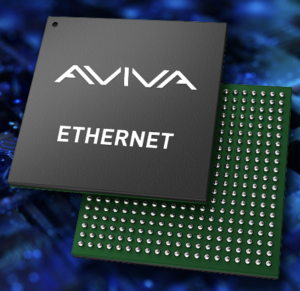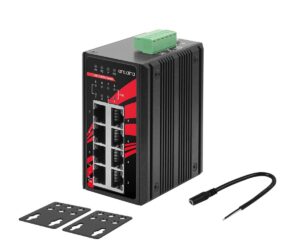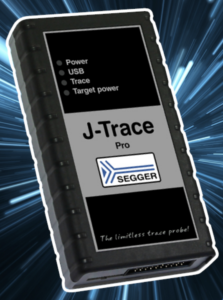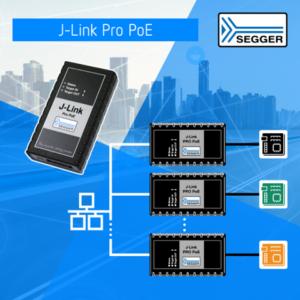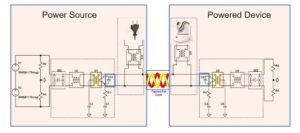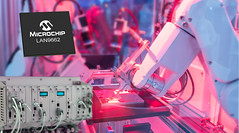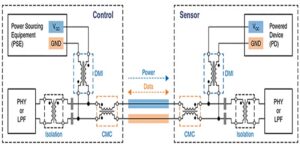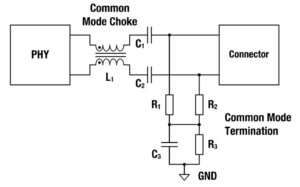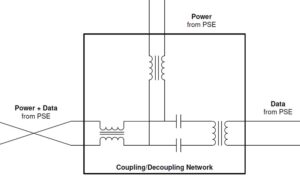AVIVA Links, Inc. announced the industry’s first family of multi-gigabit asymmetrical Ethernet devices based on the Automotive SerDes Alliance Motion Link Ethernet (ASA-MLE) draft specification. The new products include Ethernet PHYs, Switches, CSI-2 bridge ICs, and Zonal Aggregators, all of which are optimized for ultra-high bandwidth asymmetric video and control links. These devices are designed […]
Ethernet
Industrial PoE Gb switch fits into tiny spaces
Antaira launched its most compact industrial-grade PoE+ Gigabit unmanaged Ethernet switch, the LNP-C800G, a true plug-and-play networking solution designed for space-constrained areas including control cabinets and tight machinery. Thirty percent smaller than conventional switches, the LNP-C800G brings unmatched reliability, versatility, and value to factory automation, Intelligent Transportation Systems, on-vehicle networks, solar power stations, video surveillance, […]
Debugging probe covers RISC-V and Arm processors
The new flagship model J-Trace PRO is now the “all-in-one” probe for any popular CPU core and architecture. It combines all the debug capabilities of the market-leading J-Link series with all the analyzing, verifying, and code-profiling features of the J-Trace series to get a truly one-stop solution. J-Trace PRO offers multi-platform support (RISC-V, Arm), up […]
Programming tool now includes PoE test farm
SEGGER’s J-Link PRO PoE, a new member of the J-Link family, with its Power-over-Ethernet capability, is the ideal programming and debug probe for creating fast, automated, massively parallel, and reliable test farms. Quality assurance requires testing, testing, and more testing. The J-Link PRO PoE makes automated mass testing simple as it has all the features […]
Digital radio processors demodulate and decode up to four channel
Skyworks Solutions, Inc. introduced the Si469xx family of automotive digital radio coprocessors for future in-vehicle infotainment (IVI) systems. With its combination of integration, flexibility, and low cost, the Si469xx family of coprocessors is optimized to operate with Skyworks’ Si479xx Hybrid Software Defined Radio (SDR) Tuners to achieve a cost-effective digital radio receiver. The new Si469xx product family […]
What inductor characteristics are needed for PoDL in Single-Pair Ethernet?
Basic Single-Pair Ethernet (SPE) requires at least a common mode inductor (CMI). When power over data line (PoDL) functionality is added, so is a differential mode inductor (DMI) and sometimes an isolation transformer. These magnetic elements interact and can reduce SPE performance. Correctly specifying them is important to ensure efficient operation and reliable data transfer. […]
Gigabit Ethernet switch feature two integrated PHYs for industrial automation
Microchip Technology announces the LAN9662 Gigabit Ethernet Switch with four ports, Audio-Video Bridging and Time Sensitive Network (AVB/TSN), two integrated 10/100/1000BASE-T PHYs and a 600 MHz Arm Cortex-A7 CPU subsystem. To support industrial Ethernet applications, the LAN9662 features a Real-Time Engine (RTE) that provides the ability to modify the Ethernet frame in flight, enabling faster cyclical data […]
What’s the difference between an SPE isolation inductor and a transformer?
Single-Pair Ethernet (SPE) isolation inductors and transformers are available in several configurations. They are used in applications where simple capacitive isolation is not sufficient. There are two types of SPE isolation transformers, simple chip transformer designs and so-called case transformers that can combine the functions of isolation with common mode rejection. This FAQ looks at […]
How do common mode inductors work in Single-Pair Ethernet?
Common mode inductors (CMIs) are important components in all Single-Pair Ethernet (SPE) designs and are part of the coupling and decoupling network (CDN) that connects the SPE electronics to the network cabling. This FAQ begins with a brief review of the operation of CMIs and then looks at how the CDN fits into SPE designs […]
How to specify differential mode inductors for Single-Pair Ethernet?
Differential mode inductors (DMIs) are important components for Power over Data Line (PoDL) and the related Single Pair power over Ethernet (SPoE) standards. This FAQ begins with a review of where DMIs fit into Single-Pair Ethernet (SPE), then compares PoDL and SPoE implementations and application targets. Coupling and decoupling DMIs play an important role in […]

